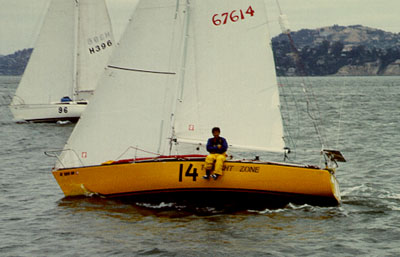
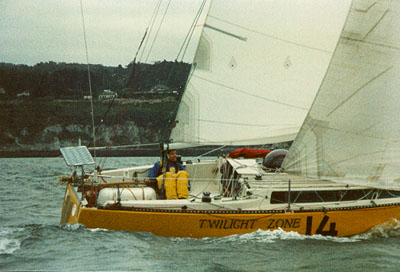 A number of modifications to the Stock Merit 25 are visible in this
photo.
A number of modifications to the Stock Merit 25 are visible in this
photo.
Most important was the main hatch modification. The standard sliding hatch cover does not seal well and is prone to leak through the front and sides, so it was replaced with a 9.5 mm (3/8") plywood deck. Adding a lexan dome to this deck provided the necessary stiffness, and a good way to keep track of things from below. The aft 30 cm of the plywood deck was hinged with a continuous plastic hinge strip to allow more space in the companionway in good weather.
The dome also allowed a great view of the spinnaker from the windward berth. It was common to lead a bight of the spinnaker sheet below so that I could trim from the berth while the autopilot steered. I could see the back half of the compass card on the bulkhead direclty above me, and reach the course increment buttons on the autopilot control without getting up.
Extra cowel vents were added to the deck just forward of this plywood
hatch replacement, in the area that the main hatch normally slides over.
Two "aft cabin window" in the form of 15 cm diameter access ports were
added to the transom. These two mods to the ventillation system kept the
air fresh inside, even with hatches closed. The transom ports were
initially covered in heavy weather, but then one of them was lost and no
water was ever observed to enter through them.

The liferaft lived in the cockpit. It was a borrowed 6-person raft, the smallest available to me with no rental charge other than the cost of re-certification. (I boarded the inflated raft during the re-certification, and decided that it was not too big despite its rating.) The front portion of the cockpt was decked over at the height of the seat tops, also with 9.5 mm plywood, attached to the cockpit sides with aluminum angles and bolts. This effectively created a bridge deck, and raised the height of the lip of the companionway to the height of the seat tops. The Honda 500 generator (which could only charge a 12-volt system at 100 watts) was stored in the new compartment under the bridge deck, but was taken out on deck for operation.
The 30 watt solar panel is visible on the stern pulpit. It could be
tipped fore and aft, but not about any other axis. In practices it didn't
seem worth while to re-alignin the panel to match the sun angle. An
additional 10 watt panel was on the cabin top, but it failed during the
race due to water leaking through to the internal wiring.
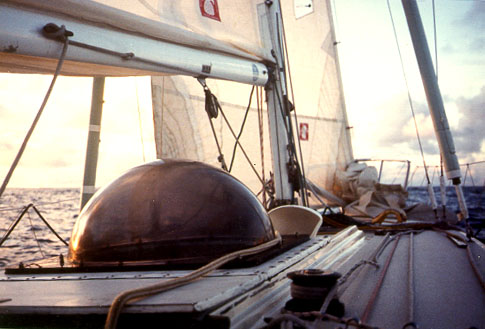
The boat was fitted with foam flotation for the trip, in the form of "dock flotation billets." These are made of low-density rigid foam and measure 23 cm x 46 cm x 244 cm (9" x 18" x 8') as sold. They were shaped to fit under the foredeck and in the cockpit lockers. The main berth cushions were closed-cell foam, tied in place. The foam had surprisingly little negative impact on storage space or crew habitability. In fact the cockpit lockers became more fucntional, because gear sat on top of the foam instead of down at the bottom of the locker, allowing easier access. About 20 cubic feet of flotation foam, including the berth cushions, was installed.
"Baggywrinkle" in the form of foam pipe insulation was used to cover the back of shte spreaders, aft lowers, and upper shrouds.
Two new external spinnaker halyards were rigged, with swivel blocks hanging from a bale through-bolted right through the mast just above the hounds fitting. One was only reeved with a light leader to save weight aloft. The second halyard was never used, because with a very clean lead from the first halyard there was virtually no detectable chafe damage.
I carried three Autopilots, all made my Autohelm: One model 800 (the
old version with the analog course dial) and two model 2000 pilots. On the
2000 units, one actuator failed and one control unit failed. The control
unit was repaired in Honalei (by Jim Cornman, who just happened to have a
spare 5v. power supply chip in his chart table), but it failed again after
the return trip was over
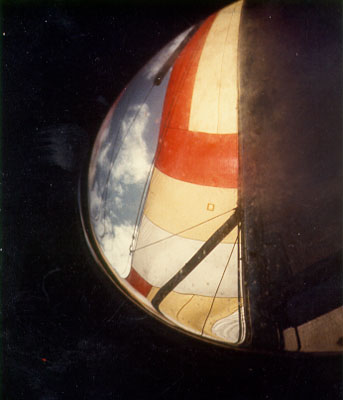
The Autohelm's steering was excellent, generally doing a good job of keeping the boat on course in moderate conditions, even with the spinnaker flying and surfable waves. In addition to the standard tiller attachment point 18 inches from the rudder stock axis, there was another pin on the tiller only 9 inches from the stock axis. This allowed for somewhat faster response and better steering in waves, but after the first actuator failure it was seldom used for fear of overloading the second actuator.
The "trysail" was made from the top half of an older mainsail. The top two battens were retained. The sail sheets to the spinnaker lead blocks, and has a "high power" position tacked at the gooseneck and a "low power" postiion tacked at the mast step.
Navigation was entirley celestial on the race over (until within AM broadcast range of Honolulu, when radio bearings were taken) and entirely by LORAN on the return.
steering and control under spinnaker was greatly facilitated by a very
unconventional spinnaker reefing line. THis was a small diameter kevlar
line running through an extra tape sewn down the centerline of one of the
spinnakers. The top of the kevlar line was tied to the halyard shackle or
head grommet of the sail. The bottom of the line exited the tape in the
middle of the spinnaker's foot, and went through a block on the stem of
the boat and then back to a spare halyard winch.
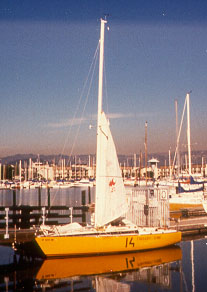
Tensioning this line had the effect of "elephant assing" the spinnaker. That is, it created a large fold down the centerline and reduced the sail's projected area. It also made the section shape of the sail more wedge-like than cup-like, resemebling twin jibs when it was "reefed" all the way. The technique only worked on a very deep reach or run, but it made possible some comfortable nights under autopilot with the spinnaker up and the boat surfing and planing. Squall strategy was greatly simplified because this single control could de-power the spinnaker down to about 50% of full power. It was also very easay to jibe with the spinnaker "dialed down."
Best day's run was 208 miles, without touching the helm (but with some help from the usual wind-driven surface current.)
There was no spinnaker net to avoid wraps around the headstay, but it was standard practice in sloppy conditions to set a #3 jib underneath the spinnaker to serve that function.
The headfoil was removed and jibs were retrofitted with jib hangs. There were two genoas that could both be hanked to the single forestay for a double wung-out jib rig. The two spinnaker poles each had a removable section that could be added to increase their length (legal under event rules) for winging out large jibs.
In practice this was seldom used. It took a long time to make the
change from spinnaker sailing to wung-out jibs, and the spinnaker reefing
system worked so well that there was little need for them.
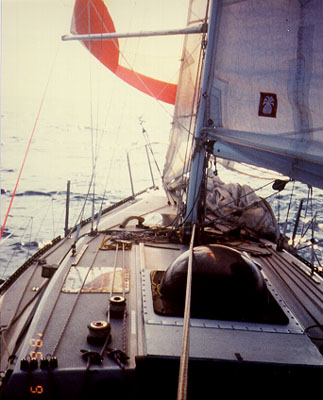
My harnesss line was usually a single line (no jacklines) attached to part of the mast step on deck. It was long enough to just allow "using the facilities" over the stern, but short enough so that I'd drag alongside the boat instead of behind it if I fell off. There was a loop of line on each stern mooring cleat that could serve as foothold for climbing back on. (The system was never tested at speed.) The harness line was also long enough to reach the bow and most of the cabin without unclipping.
The anti-collision system was based on a "Combi" radar detector, masthead srobe, and VHF monitoring channel 16. The radar detector was a Firdel "Blipper" canister that could be raised and lowered up and down the backstay on the spare main halyard, according to conditions. This arrangement was less then successful becasue the reflector wound itself around the backstay and was difficult to adjust, and appeared to be at some risk of breaking loose with the constant swinging and chafe. Ship reports on radar reflectivity were excellent, however.
I slept at night and kept watch during the day, based on the
assumption that the strobe would be much more likely to be seen by a ship
at night than the sails against an ocean full of white wave crests during
the day.
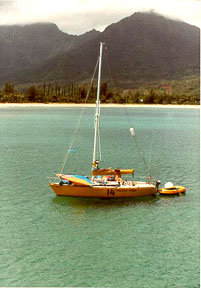
The last picture shows Twilight Zone anchored in Hanalei Bay after the race. (The sailboard and dinghy were brought out by visitors). I placed mid-fleet, mostly due to choosing a route that went too far south that year.
The return trip took 26 days, all under sail. The first week was The route went up to 41 degrees north latitude, and weather was mild headwinds most of the way for very easy and pleasant sailing. Except for the first week, which was a long starboard tack close reach up to about 38 degrees north to leave the trade winds, and then one day approaching the California coast when it was too windy to sail. "Storm" technique was to run off dead downind, bare poles, under autopilot, with four plastic milk crates towing on spare sheets a few boatlengths behind. Speed in this mode was about two knots (reduced from six knots without the drouges).
"Call me Fishmeal" (Fishmeal's home page)